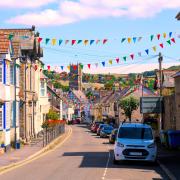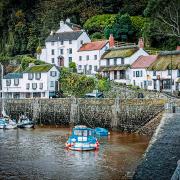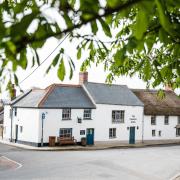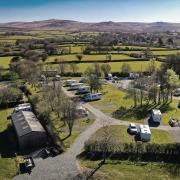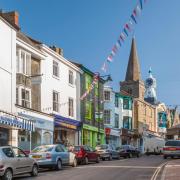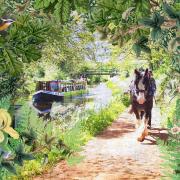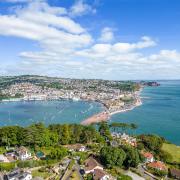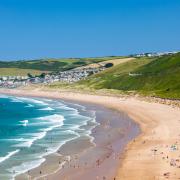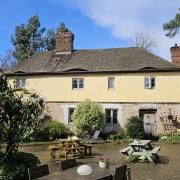With two separate coasts you’re spoilt for choice when it comes to beaches. We’ve highlighted 11 of the best to explore – whether you want to play on golden sands, explore rocky coves, build a sandcastle, fly across the waves in high adrenalin watersports or throw a ball for your dog
Best for… rockpooling

Wembury beach, South Devon
Low tide at Wembury is a magical place to be. This spectacular stretch of rugged cliffs and massive wave-cut platforms has long been renowned as one of the best places to go rockpooling in the whole of the UK. The kids and I have spent many an hour here, crouched down, wellies full of water, hoping to catch a glimpse of some of the incredible marine life that lurks beneath the waves. Cushion starfish, blennies, worm pipefish and – our top ever find – squat lobster can be spotted if you time the tide right. Better still, join a Rockpool Safari, organised by the experts at Devon Wildlife Trust’s Wembury Marine Centre, based near the beach.
wemburymarinecentre.co.uk
Best for… surfing

Woolacombe Beach, North Devon
An 18-mile stretch of the North Devon coastline was recently named as a World Surfing Reserve, joining an exclusive list of 12 that includes Malibu and Australia’s Gold Coast. It means that surf’s up pretty much anywhere around here, but Woolacombe is one of the most popular spots because of its all-round ideal conditions. Consistent swells, challenging breaks for experienced surfers and smaller waves closer to shore for beginners make it a go-to spot for all ages and abilities. There are lots of options for lessons with trained instructors at one of the local surf schools. And remember to do your bit to protect the local surf ecosystem. Surf breaks and their surrounding environments are valuable natural assets.
northdevonsurfreserve.org
Best for… dog walking

Saunton Sands, North Devon
Imagine being a dog and arriving at Saunton Sands – miles of golden sand stretching as far as you can run. No wonder so many owners and their pets enjoy being here with the wind in their ears. It’s dog-friendly all year round but if the (enormous) beach is busy, owners are politely asked to keep their canine companions on the lead until they are past the crowds (and stay to the left of the slipway). If you want to avoid the busiest part of the beach, find the path from the car park which takes you over the dunes. Numerous dog waste bins and bags are provided. Fancy staying here for longer than a walkies? Saunton Beach Villas offer dog-friendly stays.
Best for… families

Torre Abbey Sands, Torquay
When there are small children in tow, certain things matter on a beach trip. Adequate toilet facilities, proximity to good snacks (and caffeine for parents), plus lovely sheltered shallow waters that are perfect for paddling. Torre Abbey Sands has it all by the bucketful and has long been a favourite spot for holidaymakers and locals. Access is easy too, with plenty of parking nearby and easy access to Torquay town for when the kids need ice-creams, amusement arcades, pitch and putt, tennis courts and more. There’s usually a visiting funfair on nearby Torre Abbey meadows in the summer. Everyone will go home tired and happy.
Best for… seclusion
Soar Mill Cove, South Hams
If you want to beat the crowds, you usually need to head to the places accessible only by foot (or boat). Soar Mill Cove, between Salcombe and Hope Cove is certainly worth the journey. It’s a steep and unlevel trek from either Soar Mill Cove Hotel beach car park or Bolberry Down car park, so take care. But the reward is the chance to spot seals fishing close to shore and some breath-taking views of the dramatic cliffs that surround this tiny cove. At low tide, there are caves to explore.
Best for… watersports

Exmouth Beach
The sheer amount of space here at the estuary of the River Exe (around two miles, in fact) means it’s a popular playground for people who like to play on, in or just above the water. Windsurfing, kitesurfing, kayaking, paddleboarding, wing foiling and more are practised here. Exmouth has produced some champions when it comes to watersports, including sailor and Olympic medallist Joe Glanfield and kitesurfer Steph Bridge.
All have learned their craft in a place that’s certainly well set up with watersports centres and places to practise for all abilities. The ‘duckpond’, as it’s known locally, is a sheltered area of the estuary and ideal for beginners. The area around Pole Sands is a more challenging environment.
Best for… wildlife

Slapton Sands
This long shingle beach around the coast of Start Bay is part of a unique habitat and protected wildlife haven in the South Devon countryside. The beach forms a ridge between headlands of Street Gate and Torcross and separates the sea from the largest natural lake in the South West. Slapton Ley is a National Nature Reserve and home to a diverse range of birds, mammals, insects and flowers. Naturalists have carried out extensive studies here over the decades because of the area’s rare mix of scrub, grass, woodland and seaside. It’s one of the only places in Britain where you can find strapwort (a rather unassuming looking waterside plant).
Best for… sandcastles

Westward Ho!
As any seasoned sandcastle builder will tell you – it’s all about the grain. The fine material along this North Devon beach is ideal for creating the kind of structures that will become a focal point for just a short time before the tide takes your castle/racing car/hippo/turtle/mermaid-with-seaweed-hair away again. They have been known to host national competitions at Westward Ho! to raise money for charity. Most of the time, however, being king or queen of the sandcastles is an accolade to enjoy in front of your nearest and dearest, plus any other envious onlookers. Top tips: dig a water hole to help replenish your structure, pack and shape with your hands, clean up any loose sand by gently scraping a ruler or spatula to smooth the edges. Use a spoon to help create that all-important detail.
Best for… eating
South Milton Sands, Beach House
How often we have settled for soggy sandwiches and then wandered past people sat outside the Beach House, eating mackerel pate and sourdough or a sharing a seafood platter. This popular foodie hangout has the best of everything – great local produce, a simple menu (including a bar menu) and an incredible location, right next to one of the nicest beaches in this part of the world. Beach House is open all year round with lots of seating outside for summer and a cosy interior for when the weather turns. Barbecue events are planned in July and August. There really is no need to BYO soggy sarnies.
Best for… geology

Seaton and Beer
Explore the Jurassic Coast in all its glory by visiting the beaches in this wonderful part of East Devon. Rocks from all three of the World Heritage Site's geological periods - Triassic, Jurassic and Cretaceous - can be seen in their natural environment at Seaton.
Fossil hunters might get lucky here, too. Search the pebbles for fossil sea urchins in flint stones and the occasional bivalve (two-shells).
Hooken beach, to the west of Beer Head, and Seaton Hole are good places to see more bivalves and even the occasional ammonite.
Remember the fossil code: don’t dig out of the cliffs or permanent bedrock, take only small loose fossils and watch the tides.




